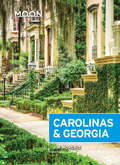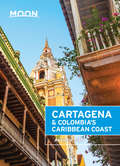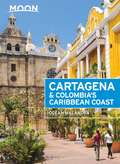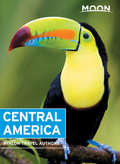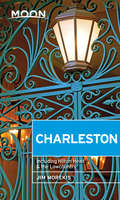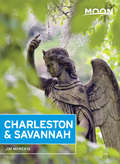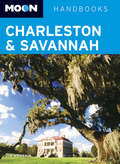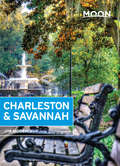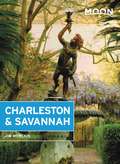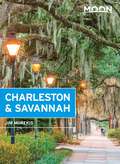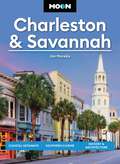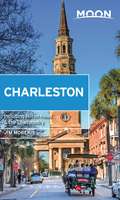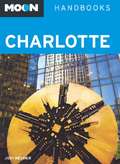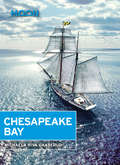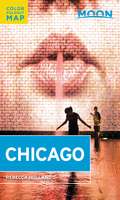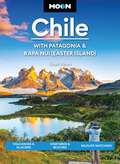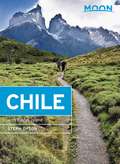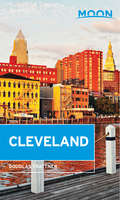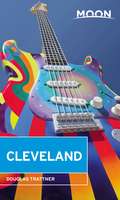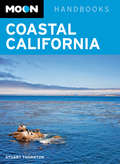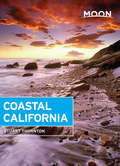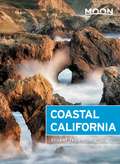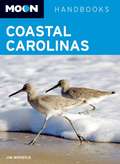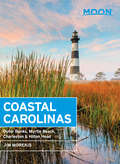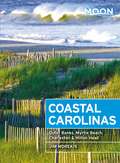- Table View
- List View
Moon Carolinas & Georgia (Travel Guide)
by Jim MorekisWriter and Savannah native Jim Morekis offers expert tips for visiting this beautiful southern region, from golfing at Nags Head to wandering through the North Carolina Museum of Art. Morekis uses his local knowledge to craft unique trip strategies for all interests, such as The Best Carolinas and Georgia Road Trip. Complete with details for hiking Great Smoky Mountains National Park, exploring the wonders of Zoo Atlanta, and relaxing on Myrtle Beach, Moon Carolinas & Georgia gives travelers the tools they need to create a more personal and memorable experience.
Moon Cartagena & Colombia's Caribbean Coast (Moon Handbooks Ser.)
by Andrew DierJoin longtime resident Andrew Dier on an unforgettable adventure. With his unique perspective and advice you can trust, Moon Cartagena and Colombia's Carribean Coast has everything you need to know to have the trip of a lifetime.Moon Cartagena and Colombia's Carribean Coast shows travelers the way to the best of these beautiful regions-whether it's swimming in the clear Caribbean waters or or celebrating a Carnaval with the locals. Along with his in-depth coverage, Dier includes unique trip ideas, including The Wild Coast and Mountain Highs. Complete with details on finding the best-secluded beaches and the most stunning archeological sights, Moon Cartagena and Colombia's Carribean Coast gives travelers the tools they need to create a more personal and memorable experience.With expertly crafted maps and gorgeous photos, this full-color guidebook gives you the tools you need to have an immersive and unique experience.Moon Cartagena and Colombia's Carribean Coast includes areas such as:CartagenaSanta Marta and the Sierra NevadaLa GuajiraWestern Carribean CoastSan Andrés and ProvidenciaFind the Moon guide that best suits your trip! Exploring more of South America? Try Moon Colombia, Moon Peru, or Moon Brazil!
Moon Cartagena & Colombia's Caribbean Coast (Travel Guide)
by Ocean MalandraRomantic cobblestone streets and ancient ruins, golden beaches and turquoise waters: Colombia's Caribbean coastline offers relaxation and adventure in equal measure. Dive right in with Moon Cartagena & Colombia's Caribbean Coast.Strategic itineraries for adventurers, nature-lovers, beach bums, history buffs, and moreUnique experiences and can't-miss highlights: Stroll through Cartagena's historic central district and admire the vivid bougainvillea cascading from balconies, dance to the sounds of salsa and champeta, or walk along the Old City's fortifications at sunset. Visit organic coffee farms, sample ceviche at a trendy sidewalk spot, or relax in a beachside cabaña at an ecofriendly hotel The top outdoor adventures: Find the best beaches for diving, snorkeling, kitesurfing, and more. Hike lush, forested mountains and look out for flashes of colorful feathers, or make the multiday trek to the ancient city of Ciudad PerdidaWays to respectfully engage with culture from local Ocean Malandra, including how to support small businesses and travel ethically and sustainablyFull-color photos and detailed maps throughoutReliable background on the landscape, history, government, and culture, including a handy Spanish phrasebookHelpful recommendations for health and safety, plus suggestions for LGBTQ+ visitors, solo travelers, travelers with disabilities, and seniorsWith Moon's expert tips and local insight, you can experience the best of Cartagena.Expanding your trip? Check out Moon Colombia.
Moon Central America
by Avalon TravelAn ebook exclusive, Moon Central America combines Moon's full-length guides to seven Central American countries into one comprehensive digital guide.Moon Central America includes the following country guides:Moon BelizeMoon Costa RicaMoon El SalvadorMoon GuatemalaMoon Honduras & the Bay IslandsMoon NicaraguaMoon PanamaFor each country, you'll find trustworthy advice from Moon's experienced travel authors. Professional photographer Al Argueta compiles the best places to take in Guatemala's awe-inspiring volcanoes, and adventure traveler Amy Robertson shares her list of Honduras's best places to get face-to-face with nature-from caves to cloud forests.If you're dreaming of a Central American trip of any length or mix of destinations, Moon Central America is the travel companion for you.
Moon Charleston
by Jim MorekisTravel writer Jim Morekis shares the must-see sights and local secrets of Charleston, from the armaments at the Battery to the delights of the French Quarter. Morekis highlights historic destinations like the Nathaniel Russell and Heyward-Washington Houses while suggesting fun and delicious features of modern Charleston, like the gaslit charm of the Peninsula Grill. Including expert advice on kayaking the gorgeous waters around Hilton Head Island and dining on she-crab soup in Beaufort, Moon Charleston gives travelers the tools they need to create a more personal and memorable experience. This full-color guide includes vibrant photos and helpful maps.
Moon Charleston & Savannah
by Jim MorekisConnect Savannaheditor in chief Jim Morekis shares the must-see sights and local secrets of Charleston and Savannah, from exploring the French Quarter to kayaking in the Golden Isles. Morekis includes unique trip strategies like Literary Lark - following the life and work of authors Robert Louis Stevenson, Edgar Allen Poe, and John Berendt - and his Kayaker’s Paradise tour. Including expert advice on walking the squares of Savannah’s Historic District and dining on she-crab soup in Beaufort,Moon Charleston & Savannahgives travelers the tools they need to create a more personal and memorable experience.
Moon Charleston & Savannah
by Jim MorekisTravel writer and Savannah native Jim Morekis shares the must-see sights and local secrets of Charleston and Savannah, from exploring the French Quarter to kayaking in the Golden Isles. Morekis includes unique trip strategies like Literary Lark-following the life and work of authors Robert Louis Stevenson, Edgar Allen Poe, and John Berendt-and his Kayaker's Paradise tour. Including expert advice on walking the squares of Savannah's Historic District and dining on she-crab soup in Beaufort, Moon Charleston & Savannah gives travelers the tools they need to create a more personal and memorable experience.
Moon Charleston & Savannah (Moon Handbooks Ser.)
by Jim MorekisAs editor-in-chief for the alternative weekly Connect Savannah, Jim Morekis knows the must-see sights and local secrets of Charleston and Savannah, from exploring the French Quarter to kayaking in the Golden Isles. Morekis also includes unique trip strategies, such as Literary Lark, following the life and work of authors Robert Louis Stevenson, Edgar Allen Poe, and John Berendt, and a Kayaker's Paradise tour. Including expert advice on walking Savannah's Historic District squares and dining on she-crab soup in Beaufort, Moon Charleston & Savannah gives travelers the tools they need to create a more personal and memorable experience.This full-color travel guide includes vibrant photos and helpful planning maps.
Moon Charleston & Savannah (Travel Guide)
by Jim MorekisWhether you're relaxing on a romantic beach, soaking up the rich history, or reveling in the Southern hospitality, dig into these fun-loving sister cities with Moon Charleston & Savannah.Explore the Cities: Navigate by neighborhood or by activity with color-coded maps of both Charleston and SavannahSee the Sights: Browse the museums on Savannah's historic River Street, take a carriage ride through Charleston's French Quarter, or check out the wares at the Old City Market. Visit Civil War battlefields, check out the First African Baptist Church, and learn about the area's important African American historyGet a Taste of the South: Sample classic shrimp and grits, juicy barbecue, or seafood straight off the boat. Savor innovative cuisine at James Beard Award-winning restaurants, and discover up-and-coming spots focusing on local, sustainable ingredientsBars, Entertainment, and Nightlife: Watch the sunset from a rooftop bar, see what's on tap at a craft brewery, or mingle with the locals at a French Quarter dive. Catch a live gig from the next big indie band, sip swanky artisan cocktails, or indulge in Savannah's to-go cup tradition on a stroll through the Historic DistrictHonest Advice: Jim Morekis was born and raised in Savannah and shares his local insight into these beautiful citiesItineraries and Day Trips: Follow itineraries designed for families, beach lovers, history buffs, foodies, and more, and get outside the city with full chapters on Hilton Head and the Lowcountry and the Golden IslesFull-Color Photos and Detailed MapsHandy Tools: Background information on the area's landscape, history, and culture, tips on getting there and getting around, and advice for travelers with disabilities, families with children, seniors, and LGBTQ+ travelersWith Moon's practical tips and local know-how, you can experience Charleston and Savannah your way.Hitting the road? Try Moon Blue Ridge Parkway Road Trip. Exploring more of the South? Try Moon Coastal Carolinas or Moon Asheville & the Great Smoky Mountains.Special ebook features:Easily navigate listings with quick searches, plus website links and zoom-in maps and imagesPersonalize your guide by adding notes and bookmarks
Moon Charleston & Savannah (Travel Guide)
by Jim MorekisWhether you're relaxing on a romantic beach, soaking up the rich history, or reveling in the Southern hospitality, dig into these fun-loving sister cities with Moon Charleston & Savannah.Explore the cities: Navigate by neighborhood or by activity with color-coded maps of both Charleston and SavannahSee the sights: Browse the museums on Savannah's historic River Street, take a carriage ride through Charleston's French Quarter, or check out the wares at the Old City Market. Visit Civil War battlefields, check out the First African Baptist Church, and learn about the area's important African American historyGet a taste of the South: Sample classic shrimp and grits, juicy barbecue, or seafood straight off the boat. Savor innovative cuisine at James Beard Award-winning restaurants, and discover up-and-coming spots focusing on local, sustainable ingredientsBars, entertainment, and nightlife: Watch the sunset from a rooftop bar, see what's on tap at a craft brewery, or mingle with the locals at a French Quarter dive. Catch a live gig from the next big indie band, sip swanky artisan cocktails, or indulge in Savannah's to-go cup tradition on a stroll through the Historic DistrictHonest advice: Jim Morekis was born and raised in Savannah and shares his local insight into these beautiful citiesItineraries and day trips: Follow itineraries designed for families, beach lovers, history buffs, foodies, and more, and get outside the city with full chapters on Hilton Head and the Lowcountry and the Golden IslesHelpful resources on COVID-19 and traveling to Charleston and SavannahFull-color photos and detailed mapsHandy tools: Background information on the area's landscape, history, and culture, tips on getting there and getting around, and advice for travelers with disabilities, families with children, seniors, and LGBTQ+ travelersWith Moon's practical tips and local know-how, you can experience the best of Charleston and Savannah.Hitting the road? Try Moon Blue Ridge Parkway Road Trip or Moon U.S. Civil Rights Trail. About Moon Travel Guides: Moon was founded in 1973 to empower independent, active, and conscious travel. We prioritize local businesses, outdoor recreation, and traveling strategically and sustainably. Moon Travel Guides are written by local, expert authors with great stories to tell—and they can't wait to share their favorite places with you.For more inspiration, follow @moonguides on social media.
Moon Charleston & Savannah: Coastal Getaways, Southern Cuisine, History & Architecture (Moon U.S. Travel Guide)
by Jim Morekis Moon Travel GuidesWhether you're relaxing on a beach, soaking up rich history, or reveling in Southern hospitality, dig into these fun-loving sister cities with Moon Charleston & Savannah.Explore the cities: Navigate by neighborhood or by activity with helpful maps of both Charleston and Savannah See the sights: Browse the museums on Savannah's historic River Street and take a carriage ride through Charleston's French Quarter. Check out the wares at the Old City Market, visit the First African Baptist Church, and learn about the area's important African American history Get a taste of the South: Sample classic shrimp and grits, juicy barbecue, or seafood straight off the boat. Savor innovative cuisine at award-winning restaurants, and discover up-and-coming spots focusing on local, sustainable ingredients Bars, entertainment, and nightlife: Watch the sunset from a rooftop bar, see what's on tap at a craft brewery, or mingle with the locals at a French Quarter dive. Catch a live gig from the next big indie band, sip swanky artisan cocktails, or indulge in Savannah's to-go cup tradition on a stroll through the Historic District Local advice: Jim Morekis was born and raised in Savannah and shares his insight into these beautiful cities Flexible itinerary and day trips: Follow a 10-day itinerary to see the best of Charleston & Savannah, and get outside the cities with full chapters on Hilton Head, the Lowcountry, and the Golden IslesFull-color photos and detailed mapsHandy tools: Background information on the area's landscape, history, and culture, tips on getting there and getting around, and advice for travelers with disabilities, families with children, seniors, and LGBTQ+ travelers Experience the best of Charleston and Savannah with Moon's practical tips and local know-how. Hitting the road? Try Moon Blue Ridge Parkway Road Trip. Exploring more of the South? Try Moon Asheville & the Great Smoky Mountains.About Moon Travel Guides: Moon was founded in 1973 to empower independent, active, and conscious travel. We prioritize local businesses, outdoor recreation, and traveling strategically and sustainably. Moon Travel Guides are written by local, expert authors with great stories to tell—and they can't wait to share their favorite places with you. For more inspiration, follow @moonguides on social media.
Moon Charleston: With Hilton Head & the Lowcountry (Travel Guide)
by Jim MorekisGet to know Charleston's fun-loving lifestyle, soak up its gothic architecture, and revel in its classic Southern charm with Moon Charleston.Explore the City: Navigate by neighborhood or by activity, with color-coded maps of Charleston's most interesting areasSee the Sights: Take a guided tour of Fort Sumter or visit the house where Harriet Tubman worked as a nurse. Admire antebellum architecture on the oldest street in the city or stroll along the harbor's Waterfront Park. Check out the evocative old churches and gothic cemeteries in the French Quarter, or do a little shopping along bustling King StreetGet a Taste of the City: Sample freshly-caught seafood, home-style Southern cooking, and the smokiest slabs of barbecue aroundBars and Nightlife: Kick back with locals at a dive bar, sip cocktails at a five-star restaurant, or explore the hip Upper King neighborhoodHonest Advice: Charleston expert Jim Morekis shares his insider tipsItineraries and Day Trips: Follow itineraries designed for families, beach lovers, history buffs, foodies, and more, and get outside the city to Hilton Head and the LowcountryFull-Color Photos and Detailed MapsHandy Tools: Background information on Charleston's landscape, history, and culture, tips on getting there and getting around, and advice for travelers with disabilities, families with children, seniors, and LGBTQ+ travelersWith Moon Charleston's local know-how and practical advice, you can plan your trip your way.Hitting the road? Try Moon Blue Ridge Parkway Road Trip. Seeing more southern cities? Try Moon Atlanta or Moon Savannah.
Moon Charlotte
by Jodi HelmerFreelance writer and green living advocate Jodi Helmer offers her firsthand experience as a Charlotte local, covering the best of the city-including artsy NoDa, the industrial South End, and the vibrant center of nightlife in Uptown. She also spotlights neighboring "NASCAR Country"-particularly Mooresville, Concord, and Kannapolis-the cities NASCAR fans flock to for race shop tours and a chance to glimpse their favorite drivers. Helmer provides a variety of unique travel strategies, including The Best of Charlotte, Fun and Free: Charlotte on a Budget, and Family-Friendly Charlotte. Complete with expert tips on the best bars, museums, and shopping areas, Moon Charlotte gives travelers the tools they need to create a more personal and memorable experience.
Moon Chesapeake Bay (Travel Guide)
by Michaela Riva GaaserudMoon Travel Guides: Make Your Escape!Moon Chesapeake Bay reveals the beauty of the Chesapeake Bay's historic cities, charming villages, and untouched natural treasures.What you'll find in Moon Chesapeake Bay:Strategic itineraries for every budget and timeline, ranging from a long weekend in Baltimore to seven days on the Eastern ShoreCurated advice for beach-goers, family vacationers, history buffs, and more, including tips for a Chesapeake Bay road tripDetailed maps and handy reference photos throughoutMust-see attractions and off-beat ideas for making the most of your trip: Explore Baltimore's myriad museums, or browse the trendy boutiques in historic Annapolis. Hike verdant trails, go rock climbing, or try your hand at sailing. Relax on a quiet stretch of secluded shoreline, or stroll along the busy Virginia Beach boardwalk. Spot wild ponies roaming freely on Assateague Island, crack softshell claws at an authentic crab shack, and unwind with a drink as the boats sway gently in the harborHonest advice from Maryland expert Michaela Riva Gaaserud on when to go, what to pack, and where to stay, from historic inns to motels or beach campgrounds Recommendations for families, LGBTQ+ travelers, seniors, international visitors, traveling with pets, and travelers with disabilitiesThorough background on the culture, weather, wildlife, and historyWith Moon's local insight, diverse activities, and expert tips, you can plan your trip your way!Coverage of: Baltimore, Annapolis and Southern Maryland, Maryland's Eastern Shore, Assateague Island, Ocean City, Delaware beaches, and coastal Virginia (Northern Neck, Williamsburg and the Historic Triangle, Hampton Roads, Virginia Beach, and Virginia's Eastern Shore)For more beach adventures, try Moon Coastal Carolinas. Exploring more of the Mid-Atlantic? Try Moon Virginia & Maryland.
Moon Chicago (Travel Guide)
by Rebecca HollandSee the City with a Local with Moon Travel Guides!Moon Chicago reveals the Windy City's perfect mix of cosmopolitan culture and Midwestern charm. Explore the City: Navigate by neighborhood or by activity with color-coded maps, or follow turn-by-turn directions for a self-guided neighborhood walkSee the Sights: Relax with the manta rays at Shedd Aquarium, listen to live music at Millenium Park, or take in some modern sculpture at the Art Institute. Venture onto the glass skydeck of the 110-story Willis Tower, or take a river tour of Chicago's historic architecture. Ride the Navy Pier Ferris Wheel, cheer on the Cubs at Wrigley Field, or grab a picnic basket, kick off your shoes, and watch the waves on Lake MichiganGet a Taste of the City: Sample Chicago beef at a classic steakhouse, grab a gourmet hot dog, or pick from dozens of high-end farm-to-table restaurants (but don't forget to try the deep-dish pizza!)Bars and Nightlife: Kick back at an authentic speakeasy before taking in a jazz show, or visit the famous Second City improv comedy club, where many of Saturday Night Live's stars got their startTrusted Advice: Local journalist and world traveler Rebecca Holland shares the secrets of her favorite cityItineraries and Day Trips: All accessible by bus, train, or public transit, including "A Winter Day in Chicago," "Chicago with Kids," and a week-long "Best of Chicago" plan Expert Tips: The best views, people-watching spots, romantic places, international cuisine, and more, plus advice for LGBTQ visitors, families with children, travelers with disabilities, and international visitorsMaps and Tools: Background information on Chicago's history and culture, as well as full-color photos and an easy-to-read foldout map to use on the goWith Moon Chicago's practical tips, unique experiences, and local know-how, you can plan your trip your way. Looking to experience more world-class cities? Try Moon Seattle or Moon Washington DC. Is Chicago just the first stop on a bigger adventure? Check out Moon Route 66 Road Trip.
Moon Chile: Volcanoes & Glaciers, Vineyards & Beaches, Wildlife-Watching (Moon Latin America & Caribbean Travel Guide)
by Moon Travel Guides Steph DysonSnow-covered mountains, bustling cities, temperate rainforests, and coastal wineries: get to know this country of contrasts with Moon Chile. Inside you'll find:Flexible itineraries, from two days in Santiago to the two-week best of Chile, including a road trip along the Carretera Austral Strategic advice for outdoor adventurers, backpackers, culture and history buffs, foodies, and more Outdoor adventures: Race down the ski slopes of the Andes, summit active volcanoes, or catch a thrill whitewater rafting down Río Futaleufú. Spend the night star-gazing in the Atacama Desert or wander the enigmatic Rapa Nui (Easter Island). Hike through Patagonia's wild national parks and spot wild pumas and Magellanic penguins Detailed hike descriptions with individual trail maps marked with duration, elevation change, and difficulty level Local flavors and culture: Explore the trendy restaurants and vibrant nightlife of Santiago or savor the catch of the day at a tiny seaside restaurant. Sip your way through the vineyards of the Casablanca Valley, sample locally-made pisco, or let loose with a terremoto cocktail. Get to know Chile's rich culture and history while strolling through charming historic quarters and visiting UNESCO World Heritage sites Insider recommendations from seasoned explorer and Chile expert Steph Dyson on when to go, where to eat, how to get around, and where to stay Full-color photos and detailed maps throughoutReliable background information on the landscape, climate, wildlife, and history With Moon Chile's practical tips and insider expertise, you can plan your trip your way. Exploring more of South America? Try Moon Patagonia or Moon Machu Picchu. About Moon Travel Guides: Moon was founded in 1973 to empower independent, active, and conscious travel. We prioritize local businesses, outdoor recreation, and traveling strategically and sustainably. Moon Travel Guides are written by local, expert authors with great stories to tell—and they can't wait to share their favorite places with you. For more inspiration, follow @moonguides on social media.
Moon Chile: With Rapa Nui (Easter Island) (Travel Guide)
by Steph DysonSnow-covered mountains, bustling cities, temperate rainforests, and coastal wineries: get to know this country of contrasts with Moon Chile. Inside you'll find:Flexible itineraries, from two days in Santiago to the two-week best of Chile, including a road trip along the Carretera AustralStrategic advice for outdoor adventurers, backpackers, culture and history buffs, foodies, and more Outdoor adventures: Race down the ski slopes of the Andes, summit active volcanoes, or catch a thrill whitewater rafting down Río Futaleufú. Spend the night star-gazing in the Atacama Desert or wander the enigmatic Rapa Nui (Easter Island). Hike through Patagonia's wild national parks and spot wild foxes and Humboldt penguinsDetailed hike descriptions with individual trail maps marked with duration, elevation change, and difficulty levelLocal flavors and culture: Explore the trendy restaurants and vibrant nightlife of Santiago or savor the catch of the day at a tiny seaside restaurant. Sip your way through the vineyards of the Casablanca Valley, sample locally-made pisco, or let loose with a terremoto cocktail. Get to know Chile's rich culture and history while strolling through charming historic quarters and visiting UNESCO World Heritage sites Insider recommendations from seasoned explorer and Chile expert Steph Dyson on when to go, where to eat, how to get around, and where to stayFull-color photos and detailed maps throughoutReliable background information on the landscape, climate, wildlife, and historyHandy tips for families, seniors, students, and travelers with disabilitiesWith Moon Chile's practical tips and insider expertise, you can plan your trip your way.Exploring more of South America? Try Moon Patagonia or Moon Machu Picchu.
Moon Cleveland
by Douglas TrattnerAward-winning journalist and Cleveland native Douglas Trattner knows the best way to experience this often overlooked mecca. After investigating every nook and cranny of his favorite city, he now shares his expertise in Moon Cleveland. Whether you're interested in exploring the 20,000 acres of Cleveland's Metroparks or spending the afternoon indoors at the famous Rock and Roll Hall of Fame, Trattner guides you to exciting activities for all ages-including hot-air ballooning over Amish Country, angling for Walleye on Lake Erie, and zipping through town on a Segway. Packed with insider's information on dining, transportation and accommodations, Moon Cleveland gives travelers the tools they need to create a more personal and memorable experience.
Moon Cleveland (Travel Guide)
by Douglas TrattnerExperience a city with Rust Belt roots and a vibrant, creative spirit with Moon Cleveland. Inside you'll find: Explore the City: Navigate by neighborhood or by activity, with color-coded maps of Cleveland's most interesting neighborhoodsSee the Sights: Root for the Cleveland Indians at "The Jake," check out the legendary costumes, instruments, and handwritten lyrics at the Rock & Roll Hall of Fame, admire industrial-era mansions, or check out the Museum of Contemporary ArtGet a Taste of the City: Dine at a trattoria in Little Italy, savor fresh fare at farm-to-table restaurants, sample falafel, pierogis, local cheeses and more at the Westside Market, and relax with a pint at a craft breweryBars and Nightlife: Catch a performance at the House of Blues, play bocce ball in an Irish pub, polka-dance at a popular local happy hour, or sip craft cocktails in a historic loungeLocal Advice: Douglas Trattner shares insider know-how on the city he calls homeItineraries and Day Trips: Explore nearby Lake Erie, Akron, and Amish Country, or follow city itineraries designed for long weekends, rainy days, and moreHandy tools like full-color photos, detailed maps, and background information on the history and culture of ClevelandWith Moon Cleveland's practical tips and local insight, you can experience the city your way.Exploring more Midwest cities? Check out Moon Chicago or Moon Minneapolis & St. Paul.
Moon Coastal California
by Stuart ThorntonTravel writer and longtime California resident Stuart Thornton covers the best of Coastal California, from hiking through redwoods in Big Sur to surfing the waves at Black's Beach in San Diego. Thornton is the perfect tour guide, offering unique trip ideas for a wide variety of travelers, including Pacific Coast Road Trip and Romantic Getaways. Packed with Thornton's expert advice on everything from choosing the best beaches to whale-watching to planning a fun side trip to Disneyland, Moon Coastal California gives travelers the tools they need to create a more personal and memorable experience.Coverage includes:San Francisco and the Bay AreaWine CountryNorth CoastMonterey BayBig Sur and the Central CoastSanta Barbara and VenturaLos Angeles and Orange CountySan DiegoThis ebook and its features are best experienced on iOS or Android devices and the Kindle Fire.
Moon Coastal California
by Stuart ThorntonTravel writer and longtime California resident Stuart Thornton covers the best of Coastal California, from hiking through redwoods in Big Sur to surfing the waves at Black's Beach in San Diego. Thornton is the perfect tour guide, offering unique trip ideas for a wide variety of travelers, including Pacific Coast Road Trip and Romantic Getaways. Packed with Thornton's expert advice on everything from choosing the best beaches to whale-watching to planning a fun side trip to Disneyland, Moon Coastal California gives travelers the tools they need to create a more personal and memorable experience.Coverage includes:San Francisco and the Bay AreaWine CountryNorth CoastMonterey BayBig Sur and the Central CoastSanta Barbara and VenturaLos Angeles and Orange CountySan Diego
Moon Coastal California (Travel Guide)
by Stuart ThorntonFrom foggy cliffs and towering redwoods to warm sands and legendary surf, explore the best of the golden coast with Moon Coastal California. Inside you'll find:Flexible itineraries including six days in Central California, five days on the North Coast, and multiple road trip itineraries that can be combined into an epic two-week Pacific Coast road tripStrategic advice for families, adventure seekers, romantic getaways, outdoor enthusiasts, foodies, and moreThe top beaches for surfing, wildlife viewing, solitude, scuba diving, snorkeling, hiking, and moreUnique experiences and can't-miss highlights: Soak up the solitude and rugged beauty of the North Coast beaches, or opt for sun and sand in San Diego. Explore the world-class museums and plunging city streets of San Francisco, sip your way through Napa and Sonoma, or gaze at skyscraping redwoods in Muir Woods. Catch a wave in a classic surf town, explore sea caves by kayak, or hike winding cliffside trails. Feast on local Dungeness crab, sample stouts at a coastal microbrewery, or find the best tacos in Los Angeles Full-color photos and detailed maps throughoutExpert advice from Monterey local and surfer Stuart Thornton on where to stay, where to eat, and how to get aroundBackground information on California's landscape, plants and animals, history, and cultureHandy tips for international visitors, seniors, families with kids, LGBTQ+ travelers, and travelers with disabilities With Moon Coastal California's local insight and practical know-how, you can plan your trip your way.Hitting the road? Try Moon California Road Trip. Headed to the national parks? Check out Moon Death Valley National Park or Moon Yosemite, Sequoia & Kings Canyon.
Moon Coastal Carolinas
by Jim MorekisMoon South Carolina author Jim Morekis covers the best of the North and South Carolina coasts, including Beaufort, Wilmington, the Cape Fear Region, Myrtle Beach, Charleston, and the Lowcountry. Morekis offers his inside knowledge on the best beaches, golfing, historic parks, and seaside dining from the Down East to the Grand Strand. Whether you're looking for a coastal weekend getaway or a longer vacation, Moon Coastal Carolinas caters to a range of travel budgets. With unique travel strategies such as "Maritime Legacy" and "The Green Coast: An Environmental Tour," Moon Coastal Carolinas gives travelers the tools they need to create a more personal and memorable experience.
Moon Coastal Carolinas: Outer Banks, Myrtle Beach, Charleston & Hilton Head
by Jim MorekisTravel writer Jim Morekis shares the must-see sights and local secrets of the North and South Carolina coasts, from the grand houses of Charleston to the breezy beaches of the Outer Banks. Morekis provides unique travel ideas for visitors such as "Coastal Carolinas for Couples” and "Carolina Lighthouses.” Including expert advice on how best to revel in the celebrations of Wilmington's flower-festooned Azalea Festival and when to visit Myrtle Beach to get the best value, Moon Coastal Carolinas gives travelers the tools they need to create a more personal and memorable experience.
Moon Coastal Carolinas: Outer Banks, Myrtle Beach, Charleston & Hilton Head (Moon Handbooks Ser.)
by Jim MorekisMoon Travel Guides: Discover the Carolinas in a New Way! Get to know this historic and beautiful stretch of American coastline, from the "wreckers" of the Outer Banks to the "snowbirds" of Hilton Head with Moon Coastal Carolinas.What you'll find in Moon Coastal Carolinas:Expert coverage from local author and born-and-bred southerner Jim Morekis. From climbing lighthouses in the Outer Banks to eating shrimp and grits in Charleston, Jim brings you his favorite things to do in the Coastal Carolinas.Full-color, vibrant photos and detailed directions and maps for exploring on your ownIn-depth coverage of The Outer Banks, North Carolina Central Coast, Charleston, Myrtle Beach and the Grand Strand, Wilmington and Cape Fear, South Carolina Low CountryStrategic itineraries in an easy-to-navigate format, such as "The Best of the Coastal Carolinas", "Coastal Carolinas for Couples", and "African American Heritage"Activities and ideas for every traveler: Sample seafood (fried, grilled, or boiled) from Elizabeth City to Port Royal, but don't forget about the barbecue! Relax on the beach or explore the hundreds of windswept waterways by boat or kayak. Go hang-gliding for a shot of adventure, or go bird-watching and enjoy nature's stillness. See the historic sights of Charleston, the site of humankind's first flight at Kittyhawk, or just breathe in that salty sea airCurrent background information on the landscape, culture, history, and environmentTips for travelers on health and safety, recreation, transportation, and accommodationWith Moon Coastal Carolinas' practical tips, myriad activities, and an insider's view on the best things to do and see, you can plan your trip your way.Heading inland? Try Moon South Carolina or Moon North Carolina! Looking for an adventure on the open road? Check out Moon Blue Ridge Parkway Road Trip.
